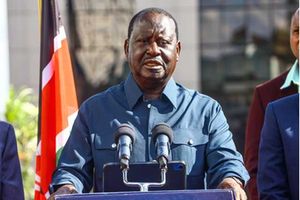Kenya joining the space race with a satellite is good news

Some of the Kenyan engineers who worked on the Taifa-1 satellite. From left: Pattern Odhiambo, the communication subsystem lead; Major Hope Deche, the ground receiver segment lead; and Captain Aloyce Were, the structural and mechanism lead. On the table is the model of Taifa-1 satellite, Kenya's first operational Earth observation satellite.
Today, Kenya will launch its first operational and earth observatory satellite, Taifa One (Nation One), designed and developed by Kenyan engineers, aboard the SpaceX Falcon 9 rocket from the Vandenberg Space Force Base in California.
Testing and manufacturing was done in collaboration with a Bulgarian aerospace manufacturer and the launch will be broadcast live on the National Aeronautical Space Agency (NASA) TV—which will help to give Kenya more brand recognition globally.
The satellite will take three months to start relaying images to its ground station, which is under construction in Kasarani, Nairobi, and greatly contribute to the country’s budding space economy. It will provide valuable data for use in improving the country’s agriculture, food security, mapping of natural resources and real-time monitoring of space weather events.
That will help the country to avert adverse conditions and disasters and among other areas. In addition, the data will help in the dissemination of geospatial data for urban planning by enabling the country to access timely and unprocessed satellite data.
The launch will lend a hand in the ongoing push by African countries for scientific innovation and the development of space programmes. Kenya now joins Egypt, which launched its satellite into space in 1998, against the background information that, by last year, more than 48 satellites had been manufactured in Africa and over 50 satellites launched from the continent, although none from the African soil.
There are eight advantages of the space exploration programmes that are beneficial to Kenya.
First, it improves healthcare through space experiments to understand health problems on earth. Secondly, it leads to protection of the planet and environment through provision of data on climate change pollution. Thirdly, it leads to creation of scientific and technical jobs, hence expanding ways through which the 900,000 youth that graduate annually in Kenya can be absorbed.
Fourth, it improves our use of products on earth, like how weather forecasting and communication is undertaken on the planet. Fifth, it enhances safety on earth through prediction of natural disasters and supports operationalisation of emergency relief efforts. Sixth, it leads to scientific discoveries by challenging our long-held assumptions and pushing our imagination beyond borders.
Seventh, it sparks youth interests in Stem—science, technology, engineering and mathematics—courses, which are needed more for advancement. Eighth, it increases the global cooperation and partnerships as envisaged by SDG 17.
Dr Giti, PhD, is an urban management, public-private partnerships (PPPs) and environment specialist. [email protected]. @danielgiti





